Database
Here I am making use of Microsoft’s Northwind Database. You can
download it from here
1. Add Typed
DataSet to the ASP.Net Website
Since I am using disconnected Crystal Reports we will make use of
Typed DataSet to populate the Crystal Reports with data from
database.
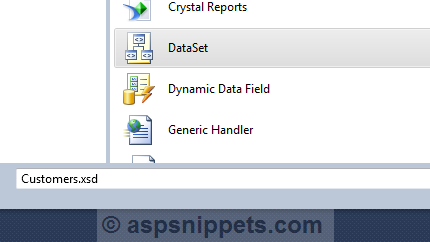
2. Adding
DataTable to the Typed DataSet
Our next step would be to add a DataTable to the Type
DataSet.
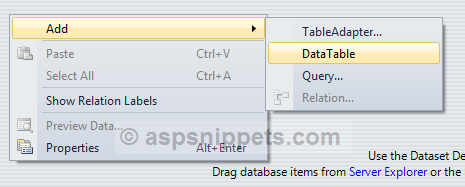
3. Adding
Columns or fields to DataTable
In the DataTable we need to specify the column names that we want to
display in the Crystal Report.
Note: The Column Names of the
DataTable must exactly match with the actual Database Table column
names.
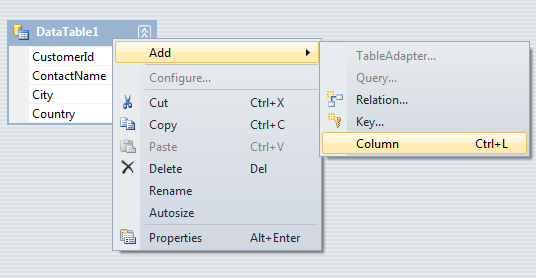
By default all the columns are of String Data Type but you can also
change the data type as per your need.
4. Adding the RDLC
Report
Using the Add New Item option in Visual Studio you need to add new
RDLC Report. I am making use of Report Wizard so that it make
easier to configure the Report.
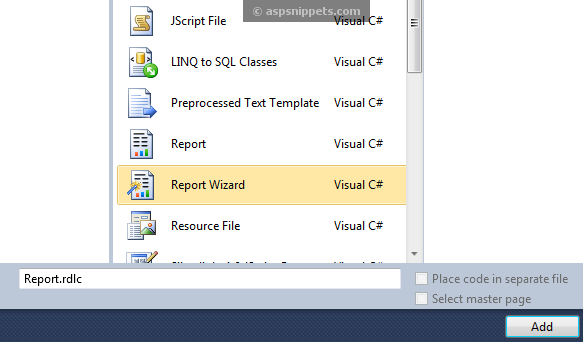
5. Choose the
DataSet
Now we need to choose the DataSet that will act as the DataSource for
the RDLC Report. Thus we need to select the Customers DataSet that we have
created earlier.
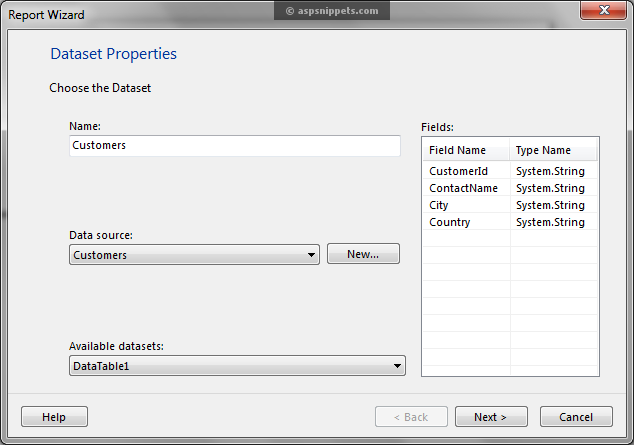
6. Choose the
Fields to be displayed in the RDLC Report
Next we need to choose the fields we need to display, we need to
simply drag and drop each fields into the Values Box as shown in the screenshot
below
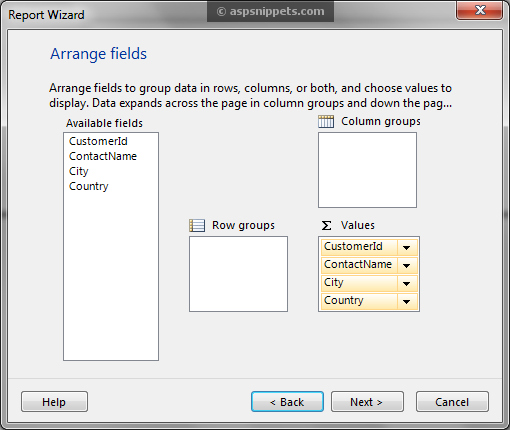
7. Choose the
Layout
The next dialog will ask us to choose the layout, we can simply skip
it as of now as this is a simple Report with no calculations
involved.
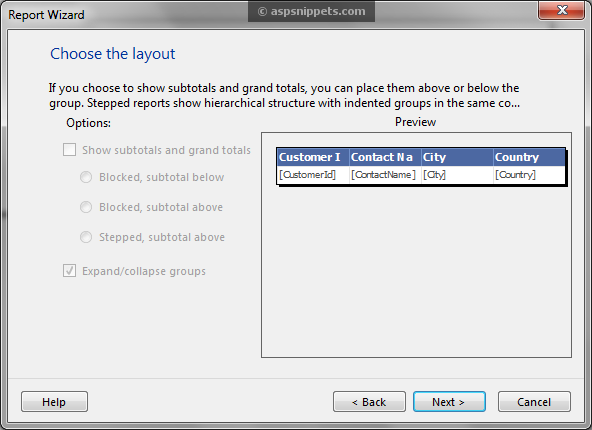
8. Choose the
Style
Finally we need to choose the style, i.e. color and theme of the
Report.
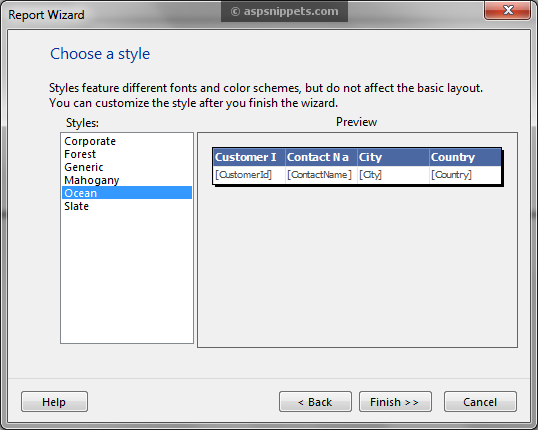
Once you press Finish button on the above step, the Report is ready
and is displayed in the Visual Studio as shown below
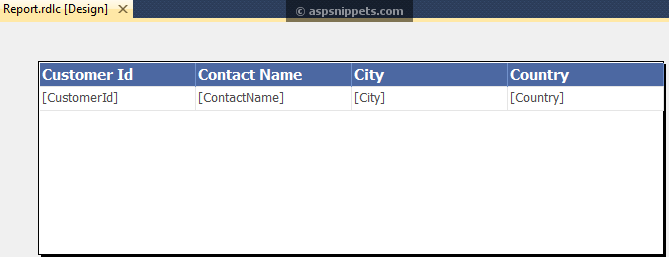
9. Adding Report
Viewer to the page
In order to display the Report we will need to add ReportViewer control
to the page from the Toolbox. The ReportViewer controls requires ScriptManager on the
page.
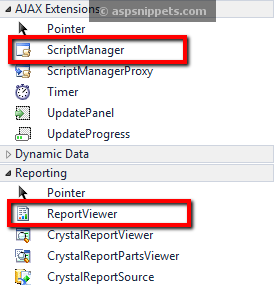
Once you add the ReportViewer control to the page, your page must
look as below
<%@ Register Assembly="Microsoft.ReportViewer.WebForms,
Version=10.0.0.0, Culture=neutral,
PublicKeyToken=b03f5f7f11d50a3a"
Namespace="Microsoft.Reporting.WebForms" TagPrefix="rsweb" %>
<!DOCTYPE html PUBLIC "-//W3C//DTD
XHTML 1.0
Transitional//EN" "http://www.w3.org/TR/xhtml1/DTD/xhtml1-transitional.dtd">
<html xmlns="http://www.w3.org/1999/xhtml">
<head runat="server">
<title></title>
</head>
<body>
<form id="form1" runat="server">
<asp:ScriptManager ID="ScriptManager1" runat="server">
</asp:ScriptManager>
<rsweb:ReportViewer ID="ReportViewer1" runat="server" Width="600">
</rsweb:ReportViewer>
</form>
</body>
</html>
10. Populating the
RDLC Report from Database
Below is the code to populate the RDLC Report from database. The
first statement notifies the ReportViewer control that the Report is of
type Local
Report.
Then the path of the Report is supplied to the ReportViewer, after
that the Customers
DataSet is populated with records from the Customers Table is set
as ReportSource to
the Report.
C#
Namespaces
using System.Data;
using System.Configuration;
using System.Data.SqlClient;
using Microsoft.Reporting.WebForms;
protected void Page_Load(object sender, EventArgs e)
{
if (!IsPostBack)
{
ReportViewer1.ProcessingMode
= ProcessingMode.Local;
ReportViewer1.LocalReport.ReportPath =
Server.MapPath("~/Report.rdlc");
Customers dsCustomers
= GetData("select top 20 * from customers");
ReportDataSource datasource
= new ReportDataSource("Customers",
dsCustomers.Tables[0]);
ReportViewer1.LocalReport.DataSources.Clear();
ReportViewer1.LocalReport.DataSources.Add(datasource);
}
}
private Customers GetData(string query)
{
string conString
= ConfigurationManager.ConnectionStrings["constr"].ConnectionString;
SqlCommand cmd
= new SqlCommand(query);
using (SqlConnection con
= new SqlConnection(conString))
{
using (SqlDataAdapter sda
= new SqlDataAdapter())
{
cmd.Connection = con;
sda.SelectCommand = cmd;
using (Customers dsCustomers
= new Customers())
{
sda.Fill(dsCustomers, "DataTable1");
return dsCustomers;
}
}
}
}
VB.Net
Namespaces
Imports System.Data
Imports System.Configuration
Imports System.Data.SqlClient
Imports Microsoft.Reporting.WebForms
Protected Sub Page_Load(sender As Object,
e As EventArgs) Handles Me.Load
If Not IsPostBack Then
ReportViewer1.ProcessingMode
= ProcessingMode.Local
ReportViewer1.LocalReport.ReportPath =
Server.MapPath("~/Report.rdlc")
Dim dsCustomers As Customers =
GetData("select top 20 * from customers")
Dim datasource As New ReportDataSource("Customers",
dsCustomers.Tables(0))
ReportViewer1.LocalReport.DataSources.Clear()
ReportViewer1.LocalReport.DataSources.Add(datasource)
End If
End Sub
Private Function GetData(query As String) As Customers
Dim conString As String = ConfigurationManager.ConnectionStrings("constr").ConnectionString
Dim cmd As New SqlCommand(query)
Using con As New SqlConnection(conString)
Using sda As New SqlDataAdapter()
cmd.Connection = con
sda.SelectCommand = cmd
Using dsCustomers As New Customers()
sda.Fill(dsCustomers, "DataTable1")
Return dsCustomers
End Using
End Using
End Using
End Function
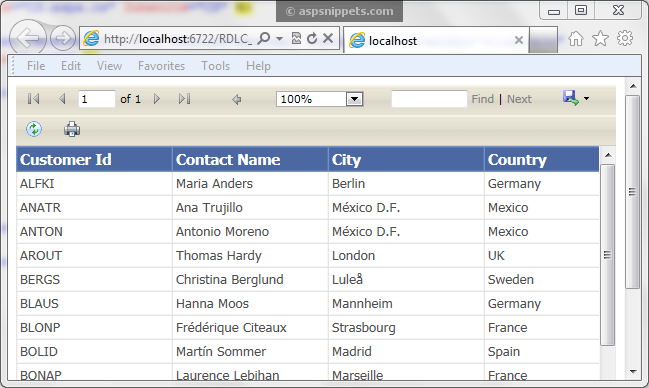
Demo
Downloads





















